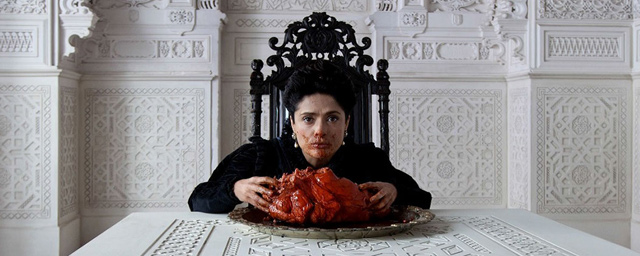By Jake Howell jake.howell@utoronto.ca
Cannes Review: The Tale of Tales
If watching Salma Hayek gorge on the giant heart of a sea monster—wrenching shreds of flesh from its ventricles and stuffing them down her gullet—sounds like your kind of thing, Matteo Garrone’s The Tale of Tales serves moments like this up on a Renaissance-style platter.

Based “loosely” on 17th-century short stories by Giambattista Basile, Garrone appropriately follows up his 2013 Cannes Grand Prix winner Reality with, well, a fantasy: unlike all other Competition films this year, The Tale of Tales comes from the fairy realm, and it’s a collection of narratives that are bizarre, moralistic, and often visceral. The scene above, for example, is a queen’s attempt to become magically pregnant, an immaculate conception that becomes the catalyst for one of the film’s competing sub-stories.
Like every fairy tale, there’s a message to take home once you close the tome’s dusty covers. Floating in this film’s several neighboring kingdoms are stories of ugly people, where the ugly ranges from truly hideous to perhaps rotten (in terms of individuals at their core). An ogre wins a princess’s hand in marriage; a king (Vincent Cassel) falls in love, sight unseen, with one of two repulsive hags; a royal prince has an identical half-brother who lives in rags. You’ve no doubt seen adaptations of these staple fables before; perhaps delivered with a script that doesn’t sometimes dip into hackneyed.
Forget the writing issues—these are fairy tales, not exactly demanding high literature—because the film is more interesting when consumed outside of that. Visually, Garrone continues his streak of crafting films that have a certain ethereal look to them, or at least steeped in the surreal. His color palettes command your eye with impressive contrasts, rich reds, and deep blues, whether it is a period piece (Tale of Tales) or inside a fish market (Reality). But here, with the brilliant assist of David Cronenberg’s go-to cinematographer Peter Suschitzky, Garrone somehow manages to stage a few tableaus that look straight from the work of Caravaggio. This isn’t hyperbole. One moment in particular reminded me most of this: we glide across the aftermath of a night of bacchanalia, a fountain besot with sumptuous vice and wine-drunk nubiles, and the scene is from the halls of the Baroque masters. Accompanied by a catchy, lilting score by Alexandre Desplat, yeah: some of this works really well.
The film is worth a sit for that.
It’s this kind of humanist aesthetic—intoxicating costume design and dramatic lighting that highlights pale skin, while staying visually expressive—that really kept me through this exercise in lavishness, because the narratives range from a little goofy (there are some gross-out sight gags) to by-the-numbers fairy tale beat points. There’s also certainly no reason to think twice on the film’s primary moral, because it isn’t anything more meaningful than essentials like The Ugly Duckling or The Prince and the Pauper. Sadly, some lackluster green screen work also took me out of it, which is a shame: many of the film’s weirder scenes involve practical effects and props, and I was disappointed to see a few seams in the digital necessities.
By the end of the two-hour running time, you’re left with a movie that takes it time to really show you some heady stuff, yet ironically I still find Garrone’s earlier work subtly more absurdist, or at least more engaging as a cinematic intersection between the real and unreal. The Tale of Tales will be a memorable Competition film this year because of images like the above—and hey, there’s one scene that totally reminds of The Princess Bride and the Cliffs of Insanity—but beyond that, it’s take-it-or-leave-it when it comes to the film’s individual stories. Woven together, with a basic through-line, it’s simply not living up to its title.













